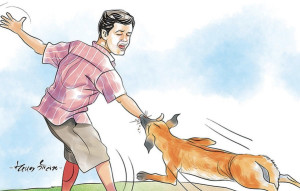Columns
Hindi-Chini Bhai-Bhai lives on
Despite flare-ups, Indo-China relations continue as usual while India treats Nepal differently.
Deepak Thapa
Remember the bad old days of the Covid-19 pandemic and the lockdowns when the only way many people kept in touch with the rest of the world was through jokes, memes and videos that popped up on our phones? There was a particular meme featuring Indian Prime Minister Narendra Modi that did the rounds, although I suspect its circulation was limited mostly to Nepalis. This one had two sections with Modi in both. The top showed him as a muscular, menacing bully while the one below had him as a pitiable, emaciated creature. It was the captions that said it all: (something to the effect) “Modi against Nepal” and “Modi against China”.
But, first, some context. It was in early May 2020 that Nepal suddenly woke up to the fact that the Indians had completed a motorable road via the pass at Lipulekh onwards to Kailash and Manasarovar in Tibet. Nationalist heckles were raised immediately and objections lodged. New Delhi shrugged off Nepal’s protestations with the argument that the road fell squarely within its own territory. The Indian Army chief even speculated that Nepalis were being aroused at “someone else’s behest”. The general perhaps failed to understand how much the issue had been hyped up in Nepal that in less than two weeks, we were forced to come up with a map that incorporated the entire territory claimed by Nepal west of the Mahakali River. Not only did we increase—on paper, at least—Nepal’s land area by 335 sq km, in the midst of a raging pandemic, Parliament was called in to amend our constitution and include the new map in the national coat of arms.
Then, in June the same year, reports came of a clash between China and India high in the western Himalaya. Since the established protocol was for border patrols not to carry any firearms, the two sides were reported to have had it out using fists, clubs and rocks. It resulted in the death of 20 Indian soldiers and an unspecified number of Chinese. Overall, though, the impression was that India had been worsted in the confrontation, and unlike with Nepal, its reaction was much more subdued. Hence, the Modi meme.
Hindi-Nepali maybe
I was reminded of this episode in recent history upon reading Arundhati Roy’s op-ed in the New York Times following Modi’s rather successful US visit just prior. Commenting on India’s relationship with China, Roy’s caustic estimation was that Modi cannot “truly stand up to China, which is India’s biggest source of imports. India is no match for China—not economically, not militarily. For years, China has occupied thousands of square miles of land in Ladakh in the Himalayas, which India considers its sovereign territory… Other than banning TikTok, Mr Modi’s government has responded with timidity and denial”.
The truth is that despite the occasional military flare-ups high up in the mountains, relations between India and China on the trade front continue as usual. The total volume of trade between the two was $136 billion in 2022, with Indian imports accounting for a whopping $119 billion of that amount. India’s reliance on Chinese imports is so great that its massive export-oriented pharmaceutical industry gets 70 percent of its active ingredients from China.
Despite the business bonhomie, tensions remain, but as Roy points out, there is little India can do vis-à-vis China without hurting its own economy. The regional power it is, India cannot take Chinese depredations at the border lying down either. As a result, Nepal has become its favourite whipping boy. And, India has many levers it can pull to make life uncomfortable for us, and that is without resorting to the blockades of quite recent memory.
As a recent article detailed, India stopped supplying explosives required for many of our development projects such as roads, hydropower and the cement industry for the simple reason that the Chinese were involved either as financiers or as contractors. Likewise, New Delhi has made it clear that it will not purchase electricity from hydro projects with any Chinese involvement. Both the Bhairahawa and Pokhara international airports are operating way below capacity—sometimes, if at all—mainly for lack of an alternative air route that Nepal has been seeking for decades only because one had a Chinese contractor and the other was built with a Chinese loan.
That India was worried about growing Chinese investments became clear during the pandemic when it revised its policy on foreign direct investment (FDI), requiring government approval for funds coming from countries sharing a land border with it. The object of this restriction was clearly China even though couched in a language applicable to all its immediate land neighbours. I am not sure how much that policy affected Nepal since figures are not easily available of the volume of Nepali investments in India, presuming this happens at some level.
The following year, however, came the shocker when India outlined its procedure for the cross-border export and import of electricity. All of Nepal’s hopes of being earning hydro-dollars from our southern neighbour came crashing down. By itself, the procedure required prior government approval for the import, trade and transmission of electricity only from “generation projects…owned, directly or indirectly by any natural/legal personality(ies) whose effective control or source of funds or residence of beneficial owner, is situated in/citizen of a third country with whom India shares land border”. Yet, entities with “effective control” appears to have been defined to include those employing Chinese contractors and Nepal is struggling to prove that otherwise. (That still does not explain India’s foot-dragging on the airports or explosives although lately there seems to be some easing up on the latter.)
To buy or not to buy
What is amazing is that all of this is happening against the backdrop of India’s quest to reach net-zero emissions by the year 2070, as declared in the 2021 COP26 summit. Not that I could have read everything written in the Indian media or by Indian scholars on the subject, but nowhere have I found any mention of the fact that Nepal can contribute to that effort quite substantially over the long term by the export of hydropower to India in the tens of thousands of megawatts. Nor have Indians decried their government’s dithering over purchasing this valuable form of renewable energy that is literally being wasted every year.
Take a recent essay by an Indian expert in the influential magazine, Foreign Affairs. “Can India Become a Green Superpower?” even talks about the Green Grids Initiative—One Sun One World One Grid, though which India hopes to create a network of power grids with countries in Southeast Asia as well as West Asia and even Africa. But it has not one reference to how India could begin to meet its emissions target by buying green energy from Nepal, and obviously not of the conditionalities imposed on Nepal.
Hundreds of billions of trade dollars flow annually between our two neighbours. But we cannot sell power to India if the Chinese are involved in our hydro projects in any capacity. Perhaps a way out of this impasse is to bring global attention to this singular hypocrisy of the Indian establishment.




 19.12°C Kathmandu
19.12°C Kathmandu















